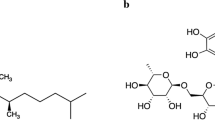Abstract
Chitosan is a biodegradable natural polymer with great potential for pharmaceutical applications due to its biocompatibility, high charge density, and non-toxicity. In this study, chitosan microspheres were successfully prepared by an adapted method of coagulation/dispersion. The degree of deacetylation of chitosan powder was obtained by NMR 1H and FTIR techniques. Chitosan powder and chitosan microspheres were characterized by BET surface area and scanning electron microscopy (SEM). The interactions among the chitosan microspheres and the vitamins A and E were characterized by FTIR. In order to evaluate the ability of interaction of vitamin A and vitamin E with the chitosan microspheres, the thermodynamic parameters were followed by calorimetric titration. Different experimental approaches were applied, such as adsorption isotherms, kinetics and thermodynamics studies. The obtained results showed that the interactions of chitosan microspheres with the vitamins were spontaneous, enthalpically and entropically favorable, indicating that the chitosan microspheres can be used with success in the controlled release of these vitamins.







Similar content being viewed by others
References
Disponível em: http://www.abihpec.org.br. Accessed 26 Fev 2010.
Manela-Azulay M, Bagatin E. Cosmeceuticals vitamins. Clin Dermatol. 2009;27:469–74.
Gao XH, Li Z, Wei H, Chen HD. Efficacy and safety of innovative cosmeceuticals. Clin Dermatol. 2008;26:367–74.
Oblong JE, Bisset DL. Retinoids. In: Draelos ZD, editor. Cosmeceuticals. 1st ed. Philadelphia: Elsevier Saunders; 2005. p. 35–45.
Darvin M, Zastriw L, Sterry W, Lademann J. Effect of supplemented and topically applied antioxidant substances on human tissue. Skin Pharmacol Appl Skin Physiol. 2006;19:238–47.
Sabliov CM, Fronczek C, Astete CE, Khachaturyan M, Khachatryan L, Leonardi C. Effects of temperature and UV light on degradation of α-tocopherol in free and dissolved form. J Am Oil Chem Soc. 2009;86:895–902.
Lehman PA, Slattery JT, Franz TJ. Percutaneous absorption of retinoids, influence on vehicle, light exposure and dose. J Invest Dermatol. 1988;91:56–61.
Berkland C, Kim KK, Pack DW. Fabrication of PLGA microspheres with precisely controlled and nanodisperse size distribution. J Controlled Release. 2001;73(1):58–74.
Dinarvand R, Rahmani E, Farbod E. Gelatin microspheres for the controlled release of all-trans-retinoic acid topical formulation and drug delivery evaluation. Int J Pharm Res. 2003;2:47–50.
Rorrer GL, Hsein TY, Way JD. Synthesis of porous-magnetic chitosan beads for removal of cadmium ions from wastewater. Ind Eng Chem Res. 1993;32:2170–8.
Prado AGS, Pescara IC, Albuquerque RDA, Honorato FN, Almeida CM. Sistema de baixo custo para produção de microesferas de quitosana. Analytica. 2010;44:62–7.
Signini R, Campana Filho SP. On the preparation and characterization of chitosan hydrochloride. Polym Bull. 1999;42:159–66.
Prado AGS, Macedo JL, Dias SCL, Dias JA. Calorimetric studies of association of chitin and chitosan with sodium dodecyl sulfate. Colloids Surf B. 2004;35:23–7.
Prado AGS, Moura AO, Andrade RDA, Pescara IC, Ferreira VS, Faria EA, Oliveira AHA, Okino EYA, Zara LF. Application of Brazilian sawdust samples for chromium removal from tannery wastewater. J Therm Anal Calorim. 2010;99:681–7.
Prado AGS, Torres JD, Faria EA, Dias SCL. Comparative adsorption studies of indigo carmine dye on chitin and chitosan. J Colloid Interface Sci. 2004;277:43–7.
Acknowledgements
The authors acknowledge the financial support and fellowships by FAP-DF, CNPq and CAPES-REUNI.
Author information
Authors and Affiliations
Corresponding author
Rights and permissions
About this article
Cite this article
Prado, A.G.S., Santos, A.L.F., Pedroso, C.P. et al. Vitamin A and vitamin E interaction behavior on chitosan microspheres. J Therm Anal Calorim 106, 415–420 (2011). https://doi.org/10.1007/s10973-011-1418-8
Published:
Issue Date:
DOI: https://doi.org/10.1007/s10973-011-1418-8




